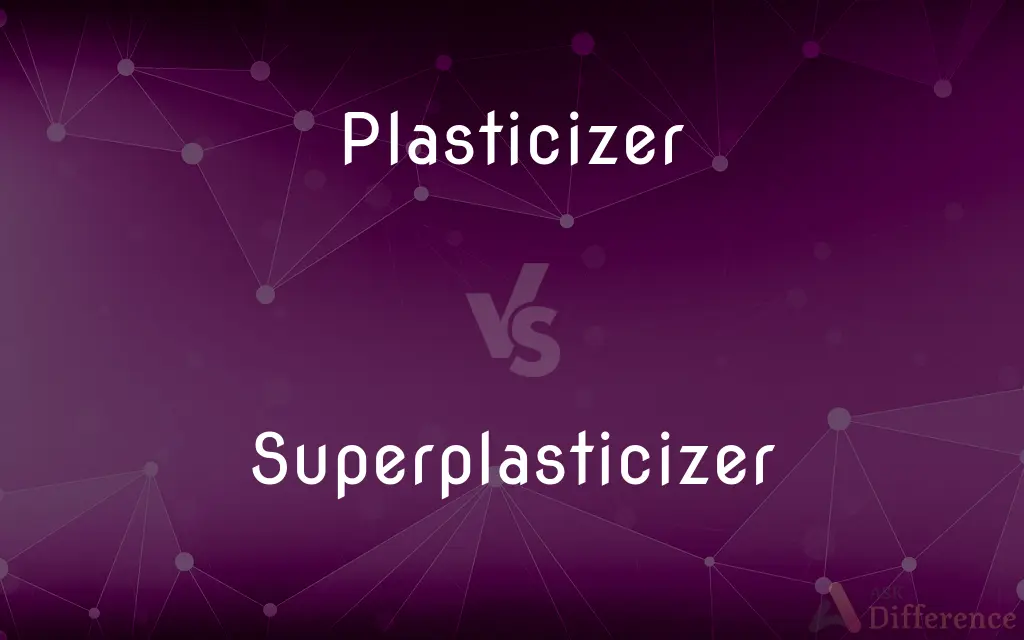Plasticizer vs. Superplasticizer — What's the Difference?
Edited by Tayyaba Rehman — By Fiza Rafique — Updated on September 27, 2023
Plasticizer is an additive that increases the plasticity or fluidity of a material, while Superplasticizer is a high-range water reducer used in concrete mixtures to improve workability without increasing water content.

Difference Between Plasticizer and Superplasticizer
Table of Contents
ADVERTISEMENT
Key Differences
Plasticizer and Superplasticizer are both additives used in construction, but they serve different functions and are used in varying quantities. A Plasticizer generally increases the plasticity or flexibility of a material, making it more malleable and easier to work with. On the other hand, Superplasticizer, as its name suggests, provides superior workability improvement, especially in concrete mixtures.
In the context of concrete, while both Plasticizer and Superplasticizer improve workability, Superplasticizers are known to achieve a high degree of water reduction without negatively impacting the strength of the concrete. Plasticizers, however, offer a moderate increase in workability with some water reduction.
The mechanism of action also differs. Plasticizers typically work by spacing out the cement particles, thereby reducing friction. Superplasticizers, however, are chemically more active and can disperse cement particles more effectively, achieving higher water reduction.
Comparison Chart
Primary Function
Increases plasticity or flexibility
High-range water reducer to enhance workability
Workability Improvement
Moderate
High, without needing extra water
ADVERTISEMENT
Mechanism of Action
Reduces inter-particle friction
Effectively disperses cement particles
Usage Amount
Generally used in larger quantities
Typically used in smaller amounts due to higher efficiency
Common Use
Various materials to improve malleability
Specifically in concrete to achieve high-strength with less water
Compare with Definitions
Plasticizer
Increases fluidity in a substance.
The inclusion of a plasticizer made the compound easier to pour.
Superplasticizer
Achieves high workability in concrete.
With superplasticizer, the concrete achieved a slump flow of 26 inches.
Plasticizer
Substance that softens when blended with another.
Adding a plasticizer to the resin allowed it to have improved ductility.
Superplasticizer
A high-range water reducer for concrete.
The contractor used a superplasticizer to make the concrete flow better without adding water.
Plasticizer
Reduces brittleness in polymers.
With the right plasticizer, the brittle polymer became bendable.
Superplasticizer
Additive for high-strength concrete production.
The skyscraper's pillars utilized superplasticizer for maximum concrete strength.
Plasticizer
An additive that enhances material plasticity.
The manufacturer added a plasticizer to the PVC to make it more flexible.
Superplasticizer
Enhances concrete properties without water increase.
Superplasticizer allowed for a robust mix without extra moisture.
Plasticizer
Modifier used to facilitate processing of a material.
The rubber compound required a plasticizer for easier molding.
Superplasticizer
Efficient disperser of cement particles.
The superplasticizer effectively separated the cement granules, creating a smooth mixture.
Plasticizer
A plasticizer (UK: plasticiser) is a substance that is added to a material to make it softer and more flexible, to increase its plasticity, to decrease its viscosity, or to decrease friction during its handling in manufacture. Plasticizers are commonly added to polymers such as plastics and rubber, either to facilitate the handling of the raw material during fabrication, or to meet the demands of the end product's application.
Superplasticizer
Superplasticizers (SP's), also known as high range water reducers, are additives used in making high strength concrete. Plasticizers are chemical compounds that enable the production of concrete with approximately 15% less water content.
Plasticizer
Any of various substances added to plastics or other materials to make or keep them soft or pliable.
Superplasticizer
A chemical used as an admixture to improve the rheology of a suspension such as concrete, reducing particle aggregation.
Plasticizer
Any of various substances added to a material (such as plastic or concrete) in order to make it more pliable.
Plasticizer
A substance added to plastics or other materials to make them more pliable
Common Curiosities
What is the main function of a Plasticizer?
A Plasticizer's primary function is to increase the plasticity or flexibility of a material.
Is the amount of Superplasticizer used in mixtures less than Plasticizer?
Yes, Superplasticizers are typically used in smaller quantities due to their higher efficiency.
Are Plasticizers limited to construction use?
No, Plasticizers are also used in other industries, especially in producing flexible plastics like PVC.
How does a Superplasticizer differ from a Plasticizer in concrete use?
Superplasticizer provides high workability improvement in concrete without increasing water content, unlike Plasticizers.
Is cost a factor when choosing between Plasticizer and Superplasticizer?
Yes, while Superplasticizers might be costlier, their efficiency and the quality of the end product often justify the expense.
Can Plasticizers be used in materials other than concrete?
Yes, Plasticizers can be used in various materials, including plastics, to improve malleability.
Why would one prefer Superplasticizer in modern construction?
Superplasticizers produce high-strength and durable concrete with less water, making them preferable in many modern constructions.
Do both Plasticizer and Superplasticizer increase workability?
Yes, but Superplasticizers achieve a higher degree of workability improvement without extra water.
What’s the main advantage of Superplasticizers in concrete?
Superplasticizers allow for high-strength concrete production without the need for additional water.
Do Plasticizers change the strength of materials?
Plasticizers mainly affect flexibility and workability; they don't necessarily increase material strength.
How do Superplasticizers achieve high workability?
Superplasticizers effectively disperse cement particles, reducing the need for water while maintaining fluidity.
Share Your Discovery

Previous Comparison
Nymph vs. Siren
Next Comparison
Toilet vs. LatrineAuthor Spotlight
Written by
Fiza RafiqueFiza Rafique is a skilled content writer at AskDifference.com, where she meticulously refines and enhances written pieces. Drawing from her vast editorial expertise, Fiza ensures clarity, accuracy, and precision in every article. Passionate about language, she continually seeks to elevate the quality of content for readers worldwide.
Edited by
Tayyaba RehmanTayyaba Rehman is a distinguished writer, currently serving as a primary contributor to askdifference.com. As a researcher in semantics and etymology, Tayyaba's passion for the complexity of languages and their distinctions has found a perfect home on the platform. Tayyaba delves into the intricacies of language, distinguishing between commonly confused words and phrases, thereby providing clarity for readers worldwide.













































